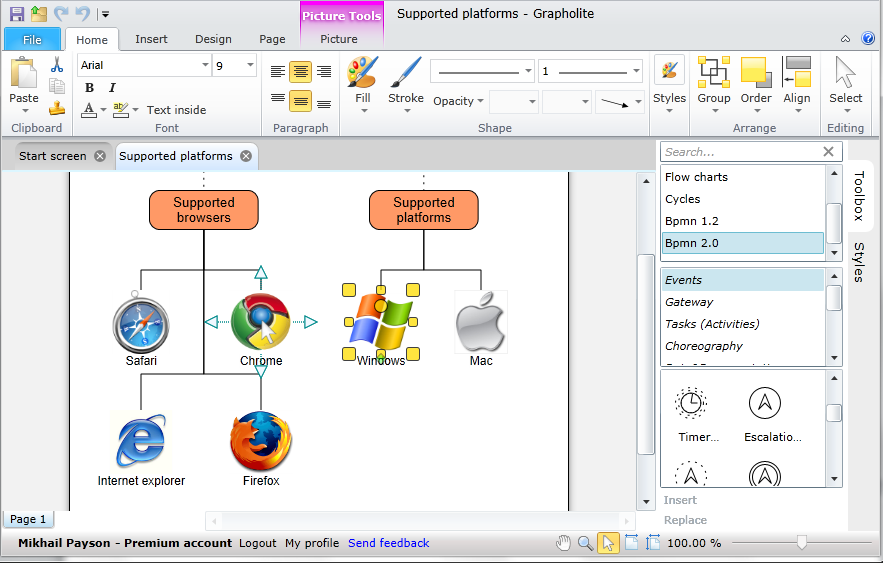Finally it’s a fact! Microsoft released Silverlight 5. It was long-awaited and finally it happened!
In my article, I am not going to talk about technical features of a new version. This subject is widely covered over Internet, for example, here (announcement from Silverlight guru, Scott Guthrie) or here. What I would like to talk about is what conclusions we can make based on all the news and discussions of this event.
 Bear Hug, The Last of the Mohicans, J. Fenimore Cooper, 1896. Illustration by F.T. Merrill |
First of all it is obvious that Microsoft is not going to stop Silverlight development and support. Otherwise they would not announce 10 years support for Silverlight 5 plug-ins. From the other side, this fact dots all the “i”s and directly says that Silverlight 6 is unlikely to be released.
Indeed, Silverlight 3 “lived” for two years (since March 18, 2009 till April 12, 2011), and the support for Silverlight 4 released in April 2010 ended on January 8 2013 (less than 3 years). Silverlight 5 released on December 9, 2011 will live till 2021. At the same time, support of users including the delivery critical updates and fixes do not have any deadline. It is not technical support of the technology that is promised to be performed till 2021, but it’s a vague commitment that most of the browsers will support Silverlight if they do not disappear till that time. |
Wars of browsers
Probably most of you have already asked yourself: what about the support for Silverlight in Microsoft browsers?
If we have a closer look at the list of supported browsers (you can see it here), it comes to the front that the maximum supporting version of Internet Explorer is IE9. At the same time, when versions of Mozilla Firefox, Google Chrome and Safari come with promising “+” symbol that implies the support for further version, there is no any “+” after IE9. This seems even stranger considering the fact that IE10 exists not just on paper and moreover, it is aggressively promoted on all conferences.
It begs the question: is there a point in 10-years support for IE9? I am sure that users in 2021 will look at IE9 with the same eyes as we are looking now at the first version of Internet Explorer (see the screenshot below). It will be interested for people only as a museum piece, but no one will use it.

Internet Explorer 1 interface. Illustration from http://www.dipity.com
So, it’s logical to ask: how Microsoft could forget about IE10 and all future versions? Answer floats on the surface: IE is intentionally excluded from a list of browsers supported by Silverlight. And I think I know why.
As you probably remember, during the sensational Build conference in September 2011 it has been announced that Internet Explorer in Metro interface is going be implemented as the “plug-in free”. This means that there will be no Flash, Silverlight or other beauties. It’s sad but nothing new and everybody has accepted the fact. They will not be supported just by the Metro version, and the developers swear that a familiar desktop version will still support them.
That is exactly why the support for IE 10 is not announced for Silverlight 5. Probably Microsoft does not want people to misunderstand the line about IE 10 and plays safe in advance. I think the same will be with future version of IE.
Considering the above, Silverlight developers should not have any new issues for concern. Most of PC users will use Windows desktop interfaces for long time and won’t hurry up with adopting the Metro interface. Furthermore, touch screen desktop is not really convenient thing to use. At the same time nothing will change for tablets and smartphones: browsers there have never supported and are not going to support Silverlight.
So, I can admit that consumer software market remains the same. Just tools will obsolete and will be replaced with new ones.
Bold ideas
But anyway, what has been changed with the releases of Silverlight 5? Should Silverlight developers move to other technologies? Or they can relax for 10 years? As always, it depends on specific tasks.
Currently there are no any powerful tools for development of Web-based RIA except Flash and Silverlight. It’s a fact confirmed even by Microsoft (to make sure we can just have a look at a list of features and improvements for Visual Studio 11). That’s is why until good solutions for Java Script development appear on the market, developers will use Silverlight , and modern trends do not matter.
However, there is an option that can save the technology and stimulate its further development. The option is to move Silverlight to open source. It can breathe life into the technology and allow it to be developed independently from the corporation policy where the disagreements between the departments become more and more obvious. It can allow keeping the Silverlight community strong and confident in the technology.
From the other side, Microsoft is unlikely to do this. First of all, opening Silverlight code will reveal potential brittleness of the components installed on millions of computers. Second, it can expose the technologies engaged in WPF and Windows Runtime which have lots in common with Silverlight.
This problem can be solved if the product is moved to semi-open-source, in other words, if to ‘farm’ it to a group mostly-trusted MVPs. And this should not be done right now until WinRT and Silverlight separate for sure, and most of the Windows smartphones use a Windows 8+ based version.
But I will not look too far into the future. Everything is in hands of Microsoft. And meanwhile we build our own plans…
Our plans
So, what are we going to do with Silverlight products by Perpetuum Software in the view of the latest news?
What I can promise for sure is that we will continue using Silverlight for creation of RIAs. It’s productive, fast and quality. HTML5 alternative is still too raw and unfriendly to place stake on it. From the other side, it is necessary to develop in this direction as well and be ready when the market brings convenient tools for fast and productive coding.

Screenshot of Grapholite (SaaS Silverlight application based on SharpShooter Diagrams)
As for our Silverlight product line, we are sure that most developers share our opinion about Silverlight and will use it for years. So, of course we will continue the development and support of our Silverlight components. All current and future versions of our products work and will work with both Silverlight 4 and Silverlight 5. And if Silverlight 6 appears, we will support it as well.
Times change… Technologies change… And we must remain flexible and adaptive…
Thank you, Rogue!
I suppose the technology lives as long as the developers use it. It can be more or less popular, but finally it’s always our choice to make its’ life longer or shorter.
Hello Alfredo,
We will think about releasing special version for SL5. However it is not necessary to have native SL5 version. You can use current version of our components in Silverlight 5 application.
You can also see this discussion on stack overflow regarding the backward compatibility of SL5: http://stackoverflow.com/questions/8474485/silverlight-5-backward-compatibility